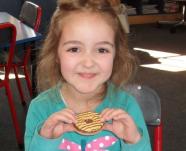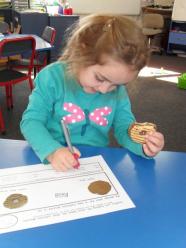Is food a technological outcome?
Inquiry
How can I grow understandings about food as a technological outcome in my years 1–2 class?
Strategy
In response to a misunderstanding about whether food can be a technological , students were given an exploratory lesson in food technology. They discussed biscuits as and the testing and trialling involved in creating a biscuit. They developed their own s - the biscuits!
Select the headings below to read more.
Background
Columba College primary school teacher Dorothy Hutton, along with colleague Cheryl Pearson, began introducing her year 1–2 class to technology concepts and terminology while also extending her own understanding of the subject. By mid-year she was increasingly confident about teaching it. Her students had enjoyed their technology lessons, and the they had gained was evident in their discussions and written work.
In term 3, when technology was a school-wide focus, Dorothy and Cheryl were allocated time to professional learning and development for their colleagues. They each worked with two other classes to help teachers enhance their technology programmes.
Dorothy had a one-hour lesson each fortnight with a year 5 and then a year 5–6 class. She structured the lessons based on what her own class had done, adapting activities to a younger or older age group as required. During these lessons, Dorothy introduced new concepts to the students while their teachers observed, and set work that the teachers supervised for the rest of the fortnight.
Student understanding of technological products
The teachers assumed students had gained a good understanding about technological products from the lessons. However, the results of the worksheet in which they were asked to identify technological products and systems revealed that there was some misunderstanding of food products. All classes used the same worksheet – Dorothy read it out to the younger students, who ticked images in a column. Most of the students, regardless of age, decided that foods were not a technological .
To correct this misunderstanding, Dorothy realised that she needed to do more than simply talk about it, so she decided to develop a targeted activity. She also needed to keep concepts simple, to avoid confusing students. The year 1–2 students talked about apples and pears as non-technological , without going too far into considering human intervention in growing food.
Planning a unit
With limited time available, Dorothy planned a one-lesson activity (one hour). Her students had done a lot of work on the strand, and she wanted to introduce them to and also focus on some . “And fun! They had developed theoretical understandings, so I wanted the children to have some experience in developing an . This activity would link the nature of technology and technological knowledge to their – bringing ideas from all three strands together in a simple way.”
While reinforcing the concept that food can be a technological , Dorothy wanted her students to realise that a lot of planning, design work, and development is involved in producing a technological product. In the hour, they would new product development in the of biscuits and make their own biscuits.
Developing a new biscuit
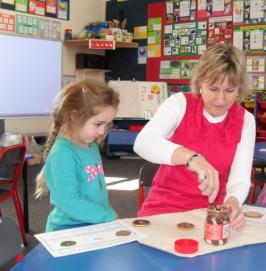
Developing a new biscuit.
Dorothy trialled the activity with her year 1–2 class on a day when a grandmother was helping in the classroom. The students enjoyed their experience and easily picked up the concepts she wanted them to understand. The next day, Dorothy repeated the unit with the year 0–1 and 5–6 classes. She started each lesson by explaining to the students that they would be doing food technology, that food technologists develop food products, and that the students would have the to develop a biscuit.
Dorothy introduced the concept of developing a new food product through a discussion about a well known type of biscuit. Dorothy brought packets of biscuits to class and explained how the company had created new biscuits. The students discussed how people get ideas for new products from thinking and talking together, and how the testing and trialling involves talking about whether an outcome should be developed further. This discussion picked up on concepts within the nature of technology strand. They looked at the company’s website and talked about how this type of company gets their ideas for new products.
For their own product development, Dorothy said: “Let’s pretend a company is looking for more ideas for new biscuits" and asked the students to develop a new biscuit. Dorothy provided five types of plain biscuit and a selection of fillings (for example, jam, honey, peanut butter, and chocolate and nut spread) and each student created their own biscuit.
"There was a lot of talking,” Dorothy says, “and the students understood that what they were doing was authentic and connected to a ‘real world’ project.” Trialling their design helped the students decide if they needed to further their and make a prototype of their biscuit.
"What if you put peanut butter on your biscuit and it breaks?” she asked the class. “Your trial will be showing that the biscuit isn’t strong enough, so you’ll to rethink your design."
The students planned their biscuits and recorded their planning on a worksheet. They described the biscuits and filling they used and evaluated their product, rating it on looks and taste from "delicious" to "doesn’t taste/look nice". The younger students were given printed images and words to stick onto the sheet, while the year 5-6 students wrote their comments.
Success
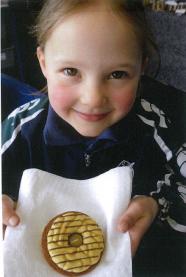
A student with her technological outcome - a biscuit!
The activity was a great success. “All the children loved it – that they’d made a new technological product that mightn’t have been made before. It was a fun, end-of-term activity.” Students in Dorothy’s class were so enthusiastic that they developed biscuits at home and brought samples in for her.
The students not only realised that food can be a technological but easily remembered the term and what it meant. Dorothy says that the unit helped her develop her own understanding of the three strands: “Technological knowledge is so embedded in technological practice in industry – they aren’t three completely separate strands, but interconnected. The activity was easily manageable in one lesson. Although it was a short activity, it helped the children realise that food products we buy have gone through a technological design and are indeed a technological .”
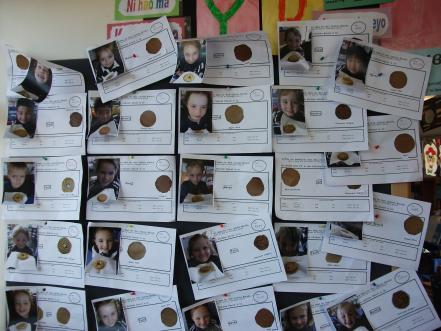
Student worksheets.

